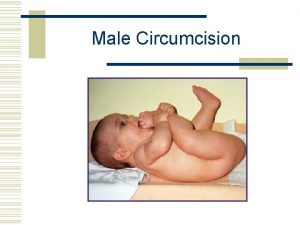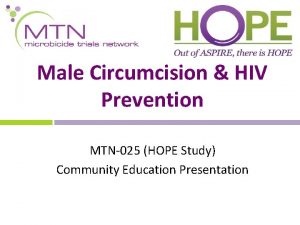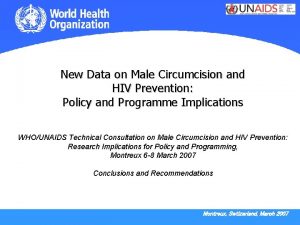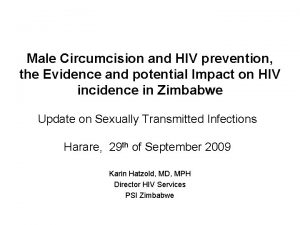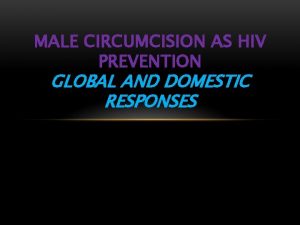New Data on Male Circumcision and HIV Prevention








- Slides: 8

New Data on Male Circumcision and HIV Prevention: Policy and Programme Implications WHO/UNAIDS Technical Consultation on Male Circumcision and HIV Prevention: Research Implications for Policy and Programming, Montreux 6 -8 March 2007 Conclusions and Recommendations Montreux, Swtizerland, March 2007

WHO International Consultation • In March 2007, after the 3 trials had proven that MC provides partial protection against HIV infection, WHO and UNAIDS convened an international consultation in Montreux and subsequently released policy and programme recommendations on MC and HIV prevention • The International Consultation was attended by a wide range of stakeholders including; government representatives, researchers, civil society representatives, gender experts, human rights and women's health advocates, young people, funding agencies and implementing partners Montreux, Swtizerland, March 2007

The Recommendations • Eleven conclusions and recommendations were detailed outlining key areas identified by the expert consultation • The recommendations cover; accepting a new additional prevention strategy, partial protection, communication, socio cultural, human rights, gender, programming, health systems, resource mobilisation, HIV positive men, and research gaps Montreux, Swtizerland, March 2007

Recommendations • Promoting male circumcision should be recognized as an additional, important strategy for the prevention of heterosexually acquired HIV infection in men • Male circumcision should never replace other known methods of HIV prevention and should always be considered as part of a comprehensive HIV prevention package • Health services should be strengthened to increase access to safe male circumcision services Montreux, Swtizerland, March 2007

Recommendations • More research is needed to determine the risks and benefits of male circumcision in specific groups • While a reduction in HIV incidence would be expected to eventually result in reduced HIV transmission to women, we do not have evidence the male circumcision provides direct benefit for women • We do not have evidence that male circumcision provides benefit to men who have sex with men • Unless there are specific medical indications, male circumcision is not recommended for HIV positive men Montreux, Swtizerland, March 2007

Recommendations • Male circumcision should be provided with full adherence to medical ethics and human rights principles, including informed consent, confidentiality, and absence of coercion • Countries with high prevalence (>15%), generalized heterosexual HIV epidemics and low rates of male circumcision should consider urgently scaling up access to male circumcision services Montreux, Swtizerland, March 2007

UN Actions UN Agencies under the leadership of WHO have a joint work plan: • The goal of the UN partners joint work plan on male circumcision is to assist countries to make evidence-based policy and programme decisions to improve the availability, accessibility and safety of male circumcision and reproductive health services as an integral component of comprehensive HIV prevention strategies Montreux, Swtizerland, March 2007

UN Actions The objectives are to: 1. Set global norms and standards 2. Provide technical support to countries 3. Conduct high level advocacy and develop global communication strategies and messages 4. Coordinate the setting of global research priorities, and develop systems for monitoring and evaluation of male circumcision services Montreux, Swtizerland, March 2007


